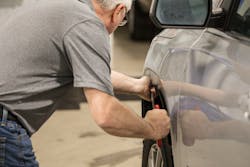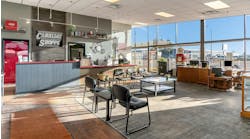Insurance company call centers love to deter customers from going with non-DRP shops with a single statement: 'We cannot guarantee the repairs if you go with a shop that is not on our approved or preferred vendor list.' And just like that, a customer can be lost. Yes, there are laws that say insurance companies cannot lead or dictate where a customer gets their vehicle fixed, but the laws leave a lot of gray areas for interpretation.
If you're a non-DRP shop, what does the insurance company actually warranty? Let me preface this with this statement: If your shop screws up or does a bad job, then you need to warranty your own repair. Bad body work, missed repairs, inaccurate repairs and a blotchy paint job are all your responsibility.
Generally, the two main things we hold the insurance company accountable for regarding warranties are aftermarket parts failing and aftermarket fitment issues. There are other things that you can hold the insurance company accountable for, but these are the two most common things I see come up. I feel the best way to delve into it is to give you some scenarios.
Issue: The aftermarket part does not fit as well as it should, and the part has already been installed or installed and painted.
Insurance Response: You should have pre-fit the part and made sure it looked correct. We will pay for a replacement OEM part, but we will not pay for labor or paint time because you should have double-checked your parts before you painted it or used the part.
Resolution: On every repair when you submit your first supplement, request R&I time for all aftermarket parts. You don't have to do it by line item, you can do a single line that says, ‘Pre-fitment of all aftermarket parts to verify accuracy and quality.’ Now, inevitably, the insurance company is going to deny pre-fitment, but what this does for you is set you up to win an argument down the line if you have an issue with any aftermarket parts.
Example: The insurance company authorizes an aftermarket bumper and aftermarket trim pieces. You request R&I time for pre-fitment of all aftermarket parts on your initial supplement and the request is denied. You run a good shop so you still pre-fit your bumper and make sure it is good before you paint it and continue the repair.
During reassembly, you find that the bumper fits well on the vehicle, but the trim pieces are ill-fitting. You take pictures of the ill-fitting parts, return the parts, get OEM trim pieces and submit your supplement request with your documentation for OEM trim pieces. Those OEM trim pieces come in and some of the parts still do not fit well. This tells us the aftermarket bumper, which we already painted, is not up to OEM specs and is misshaped.
Example Resolution: We go back to the aftermarket vendor and request warranty on the misshaped bumper. They warranty and refund you on the part but not the installation or paint time or they deny the warranty all together since the part was installed and painted. We go back to the insurance company with our documentation. We purchased the aftermarket part they requested from the vendor they told us we needed to buy it from. We requested pre-fitment of all parts to ensure no issues arose and they denied the request. We did our due diligence and pre-fit the bumper but it is unreasonable to suggest that a shop re-assemble an entire bumper before painting to verify fitment of aftermarket parts so the insurance company can save a few dollars. We did notify and request from the insurance company time to pre-fit parts to verify the accuracy and quality of parts to avoid this type of issue, but the insurance company knowingly made the decision to deny the request. The insurance company now has to make good on the repair and what they promised the consumer when they sold the insurance policy in that state. The insurance company is going to have to pay for an OEM bumper or an additional bumper if the aftermarket bumper could not be returned, along with additional body and paint times to fix the issue.
Note: For this to work you will need to have bought the parts from the vendor the insurance company requested. Also, if the vendor warranties the part or any labor and paint time you will need to adjust that in your supplement request to the insurance company when resolving this issue.
Ultimately, we need to do our best and be persistent in holding insurance companies accountable for the parts they request to be put on vehicles. If we are not going back to the insurance company every time a part is ill-fitting or malfunctions and demanding that they pay the additional time we need to take care of the issue, then they will continue to do this to us. They will push us off on aftermarket companies' warranties and guarantees to take care of paying us for the time and inconvenience of fixing these issues. That shouldn’t be our burden to bear since these insurance companies are the ones requesting the aftermarket parts. Let them go back to the aftermarket vendor and subrogate for these losses. We need to start holding the insurance companies accountable for the choices they make and force on us.



